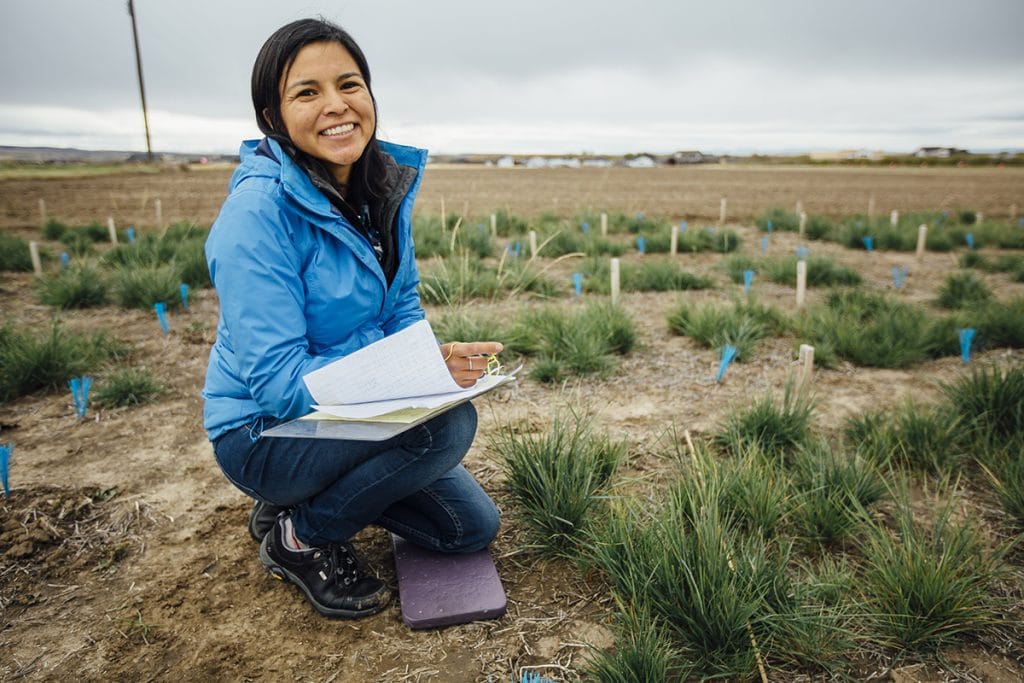For graduate student researcher Audrey Harvey, who has been recognized with a Science Post Graduate Scholarship Fund award by the American Indian Graduate Center, studying restoration ecology at Northern Arizona University’s Center for Ecosystem Science and Society is the latest step on a path that began in childhood.
“My dad works for the Navajo EPA,” said Harvey, who grew up on the Navajo Nation in Tselani Springs near Chinle, “so conversation about the land, nature and environmental work on the Navajo Nation was common in our home.” Her family raised horses and cattle and developed their own management plan for grazing. For an ethnobotany project in high school, she explored her grandmother’s use of plants to make medicinal treatments and weave rugs. “Thinking about how we interact with the land has been a lifelong story,” she said.
That story has brought her to NAU, where, with the help of the AIGC award, Harvey is pursuing a Ph.D., working with her adviser, assistant research professor Karen Haubensak, on a project to determine which native plants are better candidates for large-scale restoration projects. The postgraduate award Harvey received, worth $10,000, is given to an average of 148 awardees nationally each year, and aims to promote the advancement and inclusion of American Indian and Alaska Native students in the STEM fields, according to Corey Still, director of scholarship programs for the American Indian Graduate Center. As the nation’s largest and oldest Native scholarship provider, the AIGC works with partners to offer $15 million in direct scholarship aid each year.
Harvey is researching the “maternal effects” of plants that grow in rangelands, examining how their seed production is affected by the environmental conditions they experience. These native wildflowers, also known as forbs, are important for both pollinators and forage. As part of a multi-year USDA project, she and Haubensak’s team are asking if the conditions under which native forbs grow—their maternal conditions—predispose the seeds of those plants to be hardier, and thus good candidates for large restoration projects.
“It’s not as simple as throwing seeds on the ground,” Harvey said. “Plants need really specific conditions.” She plans to grow plants under different environmental conditions in the field, then harvest seeds to grow in the NAU greenhouse. By doing so, her team can identify which maternal conditions give forbs the best chance of producing the fittest seeds, and the most of them. “We’re asking, how can we maximize those genetic adaptations in a seed production system without losing those maternal effect advantages we saw in the greenhouse?”
Haubensak is excited to see this next phase of the project unfold.
“Audrey’s contribution is going to be a very important step toward determining how to best get native plants into the seed production pipeline for large-scale restoration projects in the western U.S.,” she said.
Harvey credits the “phenomenal” mentorship she’s had along the way for helping her find her research niche. As an undergraduate, Harvey studied environmental policy and biology at Fort Lewis College in Durango, Colorado. While there, she also worked for the Southern Ute Water Quality Program for three years, restoring riparian areas and monitoring surface water quality. This work was a great opportunity to see and experience how science works in the real world. Her mentor there, Curtis Hartenstine, recognized her enthusiasm for the plant sciences and encouraged her to look for graduate programs in that field.
Harvey did, and was accepted into a master’s program at Montana State University, where she studied invasive plant species with adviser Jane Mangold under the auspices of the Alfred P. Sloan Indigenous Graduate Partnership program. Harvey said that studying invasive species with an emphasis on management was an eye-opening approach to plant ecology that focused her interests on restoration practices.
“Restoration brings many of my interests together,” Harvey said. “I want to be working with people, on the ground, answering questions with my scientific knowledge. I’ve always wanted to work with and for people—especially people in my community, who don’t necessarily have the resources to always develop a restoration plan.”
So, for the next step in her career, Harvey looked homeward. At NAU, she found a place where she could blend her interest in researching plant and restoration ecology with her desire to apply her work on the Navajo Nation.
“It’s been a really great match from the very first time we talked,” Harvey said of her rapport with Haubensak. “Like other mentors I’ve had, Karen really supports me by saying, ‘Go and do it. Go and find it.’”
Harvey believes her research is useful to more than just land managers and scientists. “Everybody is a land manager in their own way,” she said. The knowledge she is gathering can help people growing plants in their backyard, for instance.
But being a land manager is also everyone’s responsibility. “Working with invasive species definitely gave me a huge realization: the seeds of an invasive species can collect on dogs, or your shoes, and when you go on a hike, you move them to a new place where they may not belong, or can cause damage,” Harvey said. “I don’t think everyone makes that connection that they, too, are managing the land whenever they go outside.”
Top photo: Audrey Harvey. Credit: Adrian Sanchez Gonzalez/Montana State University
Kate Petersen | Center for Ecosystem Science and Society




